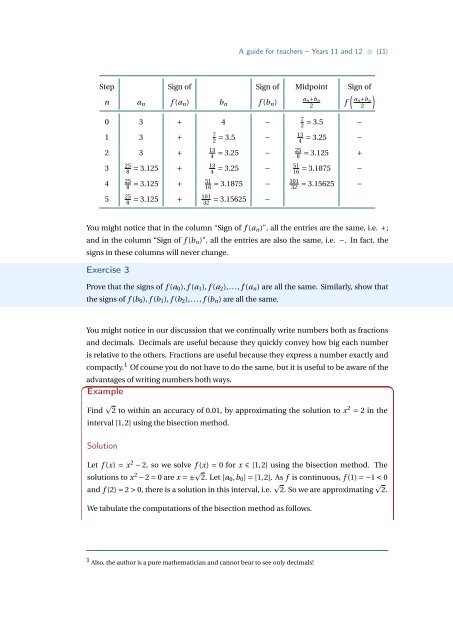numerical3j
You also want an ePaper? Increase the reach of your titles
YUMPU automatically turns print PDFs into web optimized ePapers that Google loves.
A guide for teachers – Years 11 and 12 • {11}<br />
Step Sign of Sign of Midpoint Sign of<br />
)<br />
n a n f (a n ) b n f (b n )<br />
0 3 + 4 −<br />
1 3 +<br />
2 3 +<br />
3<br />
4<br />
5<br />
a n +b n<br />
2<br />
f<br />
(<br />
an +b n<br />
2<br />
7<br />
2 = 3.5 −<br />
7<br />
2 = 3.5 − 13<br />
4 = 3.25 −<br />
13<br />
4 = 3.25 − 25<br />
8 = 3.125 +<br />
25<br />
8 = 3.125 + 13<br />
4 = 3.25 − 51<br />
16 = 3.1875 −<br />
25<br />
8 = 3.125 + 51<br />
16 = 3.1875 − 101<br />
32 = 3.15625 −<br />
25<br />
8 = 3.125 + 101<br />
32 = 3.15625 −<br />
You might notice that in the column “Sign of f (a n )", all the entries are the same, i.e. +;<br />
and in the column “Sign of f (b n )", all the entries are also the same, i.e. −. In fact, the<br />
signs in these columns will never change.<br />
Exercise 3<br />
Prove that the signs of f (a 0 ), f (a 1 ), f (a 2 ),..., f (a n ) are all the same. Similarly, show that<br />
the signs of f (b 0 ), f (b 1 ), f (b 2 ),..., f (b n ) are all the same.<br />
You might notice in our discussion that we continually write numbers both as fractions<br />
and decimals. Decimals are useful because they quickly convey how big each number<br />
is relative to the others. Fractions are useful because they express a number exactly and<br />
compactly. 1 Of course you do not have to do the same, but it is useful to be aware of the<br />
advantages of writing numbers both ways.<br />
Example<br />
Find 2 to within an accuracy of 0.01, by approximating the solution to x 2 = 2 in the<br />
interval [1,2] using the bisection method.<br />
Solution<br />
Let f (x) = x 2 − 2, so we solve f (x) = 0 for x ∈ [1,2] using the bisection method. The<br />
solutions to x 2 − 2 = 0 are x = ± 2. Let [a 0 ,b 0 ] = [1,2]. As f is continuous, f (1) = −1 < 0<br />
and f (2) = 2 > 0, there is a solution in this interval, i.e. 2. So we are approximating 2.<br />
We tabulate the computations of the bisection method as follows.<br />
1 Also, the author is a pure mathematician and cannot bear to see only decimals!


